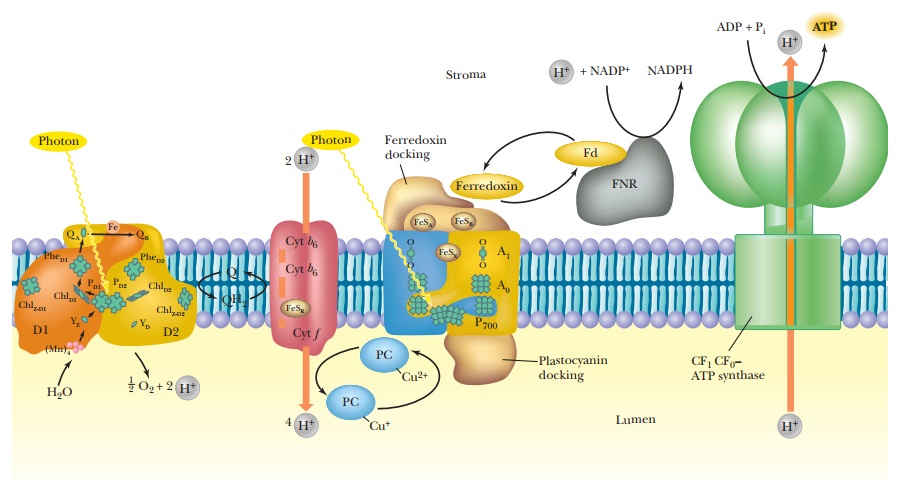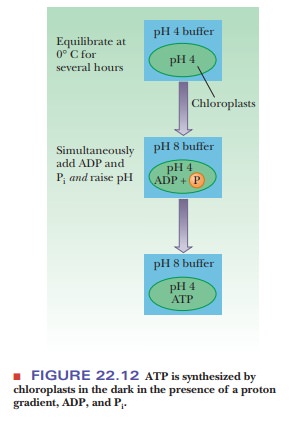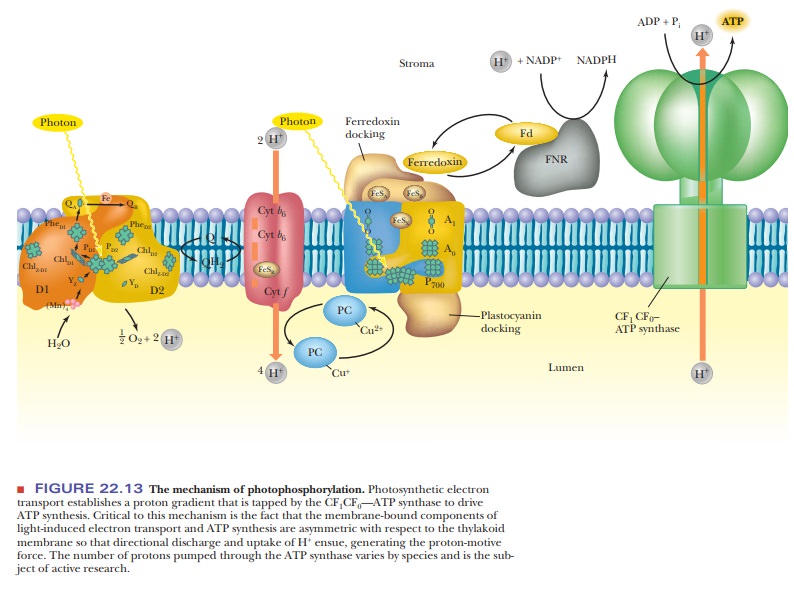Chapter: Biochemistry: Photosynthesis
Photosynthesis and ATP Production

Photosynthesis and ATP Production
We saw that a proton gradient across the inner mitochondrial
membrane drives the phosphorylation of ADP in respiration. The mechanism of
photophosphorylation is essentially the same as that of the production of ATP
in the respiratory electron transport chain. In fact, some of the strongest
evidence for the chemiosmotic coupling of phosphorylation to electron transport
has been obtained from experiments on chloroplasts rather than mitochondria.
Chloroplasts can synthesize ATP from ADP and Piin the dark if they are provided with a
pH gradient.

If isolated chloroplasts are allowed to equilibrate in a pH 4
buffer for several hours, their internal pH will be equal to 4. If the pH of
the buffer is raised rapidly to 8 and if ADP and Pi are
added simultaneously, ATP will be produced (Figure 22.12). The production of
ATP does not require the presence of light; the proton gradient produced by the
pH difference supplies the driving force for phosphorylation. This experiment
provides solid evidence for the chemios-motic coupling mechanism.
How does ATP production in chloroplasts resemble the process in mitochondria?
Several reactions contribute to the generation of a proton gradient in chloroplasts in an actively photosynthesizing cell. The oxidation of water releases H+ into the thylakoid space. Electron transport from photosystem II and photosystem I also helps create the proton gradient by involving plastoquinone and cytochromes in the process. Then photosystem I reduces NADP+ by using H+ in the stroma to produce NADPH. As a result, the pH of the thylakoid space is lower than that of the stroma (Figure 22.13). The ATP synthase in chloroplasts is similar to the mitochondrial enzyme; in particular, it consists of two parts, CF1 and CF0, where the C serves to distinguish them from their mitochondrial counterparts, F1 and F0, respectively. Evidence exists that the components of the electron chain in chloroplasts are arranged asymmetrically in the thylakoid membrane, as is the case in mitochondria. An important consequence of this asymmetrical arrangement is the release of the ATP and NADPH produced by the light reaction into the stroma, where they provide energy and reducing power for the dark reaction of photosynthesis.

In
mitochondrial electron transport, four respiratory complexes are con-nected by
soluble electron carriers. The electron transport apparatus of the thy-lakoid
membrane is similar in that it consists of several large membrane-bound
complexes. They are PSII (the photosystem II complex), the cytochrome b6–f complex, and PSI (the photosystem I complex). As in
mitochondrial electron transport, several soluble electron carriers form the
connection between the protein complexes. In the thylakoid membrane, the
soluble carriers are plas-toquinone and plastocyanin, which have a role similar
to that of coenzyme Q and cytochrome c
in mitochondria (Figure 22.13). The proton gradient created by electron
transport drives the synthesis of ATP in chloroplasts, as in mitochondria.
Summary
The mechanism of ATP in chloroplasts closely resembles the process
that takes place in mitochondria. The structure of the ATP synthase in
chloro-plasts is similar to that in mitochondria.
Related Topics